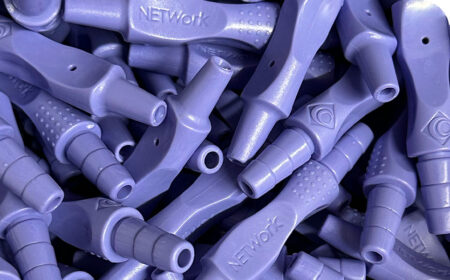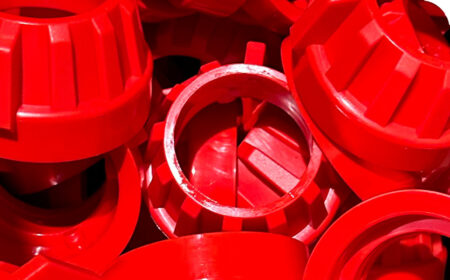We’ll collaborate with you to craft a practical design that’s suitable for your product. As an experienced plastic manufacturer, we’ll guide you through the process from start to finish.
We provide precision plastic moulding services for a wide range of industries. Our team has the expertise to recommend the best approach for your product requirements. Every specialist product is handled with care to deliver a high-quality result, and we never settle for less.
Sectors
If you’re looking to develop a new product or improve an existing one, we can guide you through the process. Your project is handled completely in-house for a quality, cost-effective result.
Learn More
Already have an injection mould tool but looking to change plastic manufacturing company? We specialise in repeat production of injection-moulded products for a wide range of industries.
Learn MoreWe answer your common questions surrounding our moulding and tooling services.
Get in TouchWhat is plastic injection moulding?
Injection moulding is the method of injecting molten plastic into a mould, cooling and solidifying it to create a specific moulded shape, and then ejecting it. This technique is commonly used for mass producing plastic parts, and plays a key role in the plastic manufacturing industry. It’s used across a variety of sectors such as automotive, medical, consumer goods, and construction. The parts produced from this process vary greatly in size and purpose, but some examples include car headlight surrounds, plastic syringes, and model airplane parts.
What is the plastic moulding process?
The plastic manufacturing process can be complex, and may require other considerations depending on the product, but as a general rule, there are four main stages:
Setup/Clamping – Both halves of the mould are attached to the moulding machine plates. One half is referred to as the moving half, while the other is known as the fixed half. Both sides are held tightly together while the molten plastic is injected.
Injection – Plastic pellets are fed into the moulding machine’s hopper, and gravity fed into the barrel. An archimedes screw moves the pellets through the barrel, and the heat and sheer pressure of this process melts the pellets. The molten plastic moves into the nozzle and is injected into the mould itself. When 95-99% of the mould is filled, the injection stops.
Cooling – After the mould is full, the plastic inside begins to cool and harden to the mould’s shape. As it cools, the shape will shrink slightly depending on the material used. It’s important to leave the plastic to cool completely before removing it from the mould.
Ejection – At this final stage, force is used via a stripper plate or ejection pins etc. to eject the moulded product from the cavity of the mould. The product then falls on to a conveyor or is robotically removed for packing or further processing. After this, the mould is clamped shut again and the process starts its next cycle.
What raw materials can plastic injection moulders use?
There is a variety of different thermoplastics that can be used for the moulding process. Bowles and Walker provide a range of options, and specialise in 8 primary materials.
Polypropylene (PP) – Low density, low cost and combinable with other materials. Excellent chemical and fatigue resistance. PP is typically used for packaging, parts, machinery, and textiles.
Acrylonitrile Butadiene Styrene (ABS) – A great choice for structural applications. It’s strong, stiff, and tough, and holds its shape under stress. You’d find this material in lego blocks or keys on a keyboard.
Polycarbonate (PC) – Strong, transparent plastic that has uses in the automotive, electronics, and construction industries for clear protection screens, casing, or covers.
High Impact Polystyrene (HIPS) – HIPs is a blend of polystyrene and a small percentage of rubber to become impact resistant. Used for both commercial and domestic applications such as children’s toys, packaging inserts, and bathroom cabinets, this is ideal for the indoors but not recommended for outdoor uses.
Low Density Polyethylene (LDPE) and High Density Polyethylene (HDPE) – LDPE is soft, flexible, and chemical resistant but can’t handle temperatures over 80°C. It is often used for trays, containers, flexible parts, plugs, and pipes. HDPE has very similar properties to LDPE, but is more rigid and has a better resistance to heat.
Nylon or Polyamide (PA) – As a well known engineering plastic, PA can withstand high temperatures and is a great electrical conductor. These properties make it ideal for fuses and circuit breakers. It’s also commonly used in the automotive industry to reinforce high impact areas in cars.
Polymethyl Methacrylate (PMMA) – Well known as the material behind “Plexiglass”, PMMA is clear, rigid and hard. PMMA is often used in vehicle lights, safety glass, acrylic nails and glass lenses.
If you’re not sure which plastic would suit your project, the Bowles and Walker team are happy to advise you on the ideal material for your products requirements.
How much will it cost?
The cost of manufacturing plastic parts varies greatly. Most of the expenditure goes on design and production of a moulding tool for your product’s requirements. Once the tool has been created, routine plastic moulding tends to be a lot cheaper, but this can also vary based on production volume, cost of the plastic material, and the level of precision required. No matter the project, budget or scope, Bowles and Walker will collaborate and consult with you to advise on the most cost effective solution for your manufacturing process.
What are the benefits of injection moulded plastic parts?
There are many advantages to using injection moulding in your manufacturing process. The key selling point is that you can produce a large amount of plastic parts quickly and cost effectively, without compromising on quality. Some other benefits include:
Consistency – With a quality, well cared for moulding tool, you can continue to produce identical plastic parts.
Precision plastic injection moulding – Compared to other techniques, injection moulding allows for more intricate details and features on a very small plastic part. This provides more flexibility and functionality for plastic parts made with this method.
Speed – This varies based on the detail, size, and precision of the required product, but cycle times can be as low as 10 seconds. Other techniques such as 3D printing would take a significantly slower amount of time.